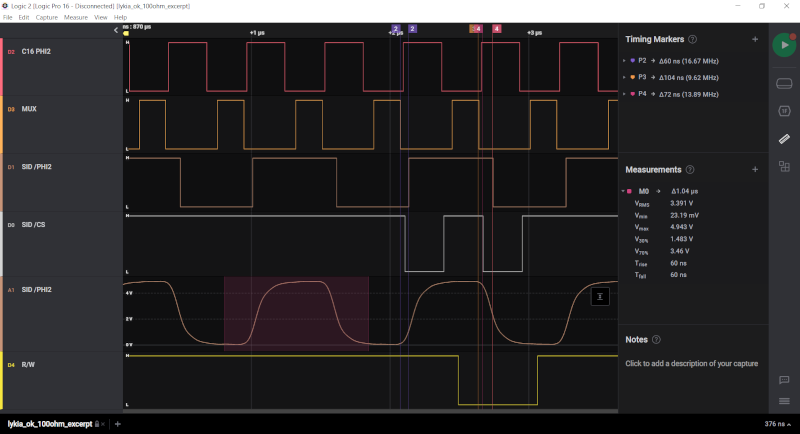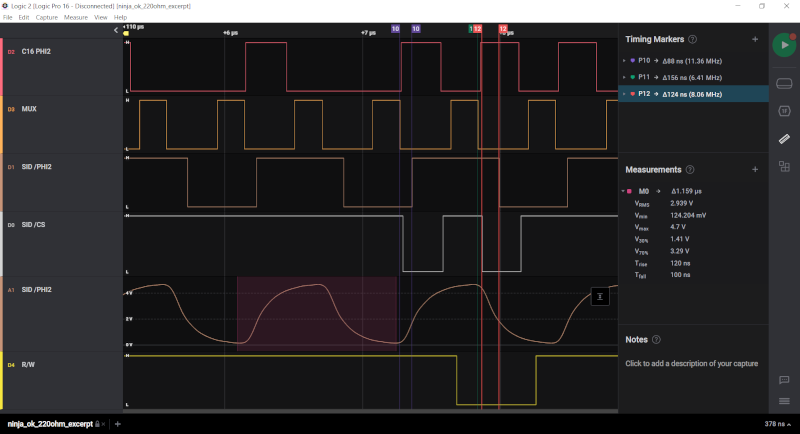Posted By

SukkoPera
on 2022-08-29
08:41:40
|  Re: Solder's SIDcard Replica Re: Solder's SIDcard Replica
My hack seems to work!
The idea was simply to delay the generated SID PHI2 a bit. For that, project contributor Kinmami suggested to use an RC network, here's the result:

See? PHI2 now stays high a small bit past the second falling edge of /CS and even if that is just 72 ns, it seems enough for the write to make it through, as I can no longer hear any artifacts in the sound output! The RC network I used for this screenshot was 100 ohm + 470 pF, which I like as it uses components that are already used elsewhere on the board, so there's no need to buy other stuff!
I also tested with 220 ohm:

This raises the margin to 124 ns which apparently seems safer, but it starts to distort the signal a bit too much for my tastes. Besides, I cannot hear any differences, sound-wise. Taking into account that older 4520's cannot introduce too large a delay (I'll measure that when I get the parts I bought), I'd recommend sticking to 100 ohm.
NOTE: While I was making these tests, I was using a SwinSID Nano. Initially I could hear no difference, which got me pretty upset. Then I realized it kept working even if I disconnected the clock! So I looked for information and found out that the SwinSID does not care at all for the external clock, it generates its own internally. This means it is bound to working at the C64 frequency only and cannot be used on C16 SIDcards running at MUX/2. It would be nice if someone patched the SwinSID firmware for an alternative clock speed or if it just used the provided clock.
So the card is now working fine. I have already added the delay circuit to the PCB project (if one wants to use an old 4520, they can just use a 0 ohm resistor or bridge it). The last issue to solve is that the step-up voltage regulator is producing a bit too much noise. Can anyone report if the original SIDcard has a lot of hiss/whistling?
@TLC: Thanks for the info, that confirms that a very specific part is needed, and now it's documented for the future generations! Believe it or not, I absolutely s*ck at electronics when it comes to the analog aspects of signals or to how ICs are built and what characteristics they have. I used to think that CMOS would be faster, so Solder's note on his schematics "Normal CMOS" had me thinking that an HCT part would work. Oh well, that's the price for coming from the software world, I guess  . .
I agree that feeding the SID from a variable-speed bus is a huge hack that works by pure chance and thus I'd really recommend future SIDcard programmers to do what @gerliczer suggested initially: only access the SID during single-clock periods. That would definitely make things way more reliable.
Also thanks for your other suggestions, those are actually some of the modifications we have already made to the original design and which I have been talking about: we have removed the second stage of the amplifier and made sure that the first stage used the same values as the C64. These days you can easily do better amplification outboard. We have also added a volume control for the DigiFix and even a switch to completely bypass it. We have also recalculated the values for the step-up converter and came up with alternative ones for the 6581 SID, which is what I am actually using in my tests.
I'll wait for the old 4520's to arrive, test them and then make the project available for the public! Guess it will take a couple more weeks but we're close!
|